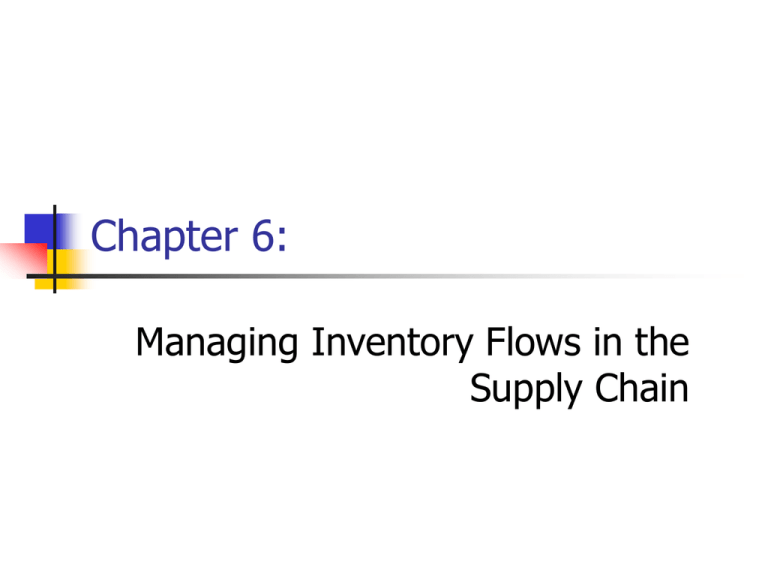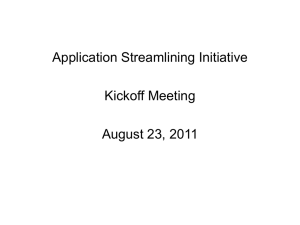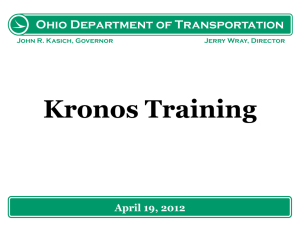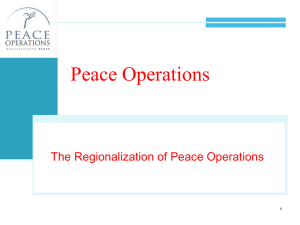Chapter 6
advertisement

Chapter 6: Managing Inventory Flows in the Supply Chain Logistics Profile: Micros and More “Inventory, inventory, inventory….I am sick and tired of hearing complaints about our inventory levels and the costs associated with carrying inventory,” muttered the COO. What so important is this statement? Chapter 6 Management of Business Logistics, 7th Ed. 2 Micros and More Inventory has a direct impact to company’s performance. Management seeks Inventory management and control as a key business logistics activity Thus, it is useful to understand the importance of inventory from a broad, macroeconomic prospective We need to gain understanding of: Chapter 6 Management of Business Logistics, 7th Ed. 3 Micros and More What is the role of inventory? What are the important trade-offs in the management of inventory? What are the relevant inventory costs? Can the supply chain help control inventory? Solutions to these questions is important, because: Chapter 6 Management of Business Logistics, 7th Ed. 4 Management of Inventory Flows in the Supply Chain: Introduction Inventory as an asset has taken on increased significance as companies struggle to reduce investment in fixed assets that accommodate inventory (plants, warehouses, etc.). Changes in inventory affect return on assets (ROA), an important internal and external metric. Ultimate challenge is to balance supply and demand for inventory. Chapter 6 Management of Business Logistics, 7th Ed. 5 Example: Inventory in the Economy Inventory in the Economy has decreased. As a percentage of the GDP, from 1985 to 2000, inventory levels have decreased from 5.4% to about 3.8% Examine Table 6-1. Chapter 6 Management of Business Logistics, 7th Ed. 6 Table 6-1: Macro Inventory Cost in Relation to U.S. Gross Domestic Product Chapter 6 Management of Business Logistics, 7th Ed. 7 On the Line: Inventory Turns Think of inventory turns as a measure of how well a company’s products are doing in the market and how well its inventory is managed. There is a continuing move away from traditional build-to-forecast manufacturing models to more flexible build-to-demand systems. Increasing emphasis on fully integrated supply chain means inventories barely spend any time sitting idle. “Ideally, zero inventory will maximize cash flow.” Inventory turnover potential is 30 to 40 times/year. Chapter 6 Management of Business Logistics, 7th Ed. 8 Inventory in the Firm: Rationale for Inventory Product Line Proliferation Depth & breath of product lines trending up. Results in larger inventories. Examine Table 6-2 Total Logistics Costs-1999. Inventory carrying costs of $332 billion approach 35 percent of total logistics costs for companies. Chapter 6 Management of Business Logistics, 7th Ed. 9 Table 6-2 Total Logistics Costs --- 1999 Chapter 6 Management of Business Logistics, 7th Ed. 10 Inventory in the Firm: Three types of inventory: 1. Physical supply inventories 2. Physical distribution inventories 3. Functional inventory We will discuss each of them next! Chapter 6 Management of Business Logistics, 7th Ed. 11 1. Physical supply inventories Use to support a firm’s processing, manufacturing, or assembly functions Reasons for accumulating materials: a. Purchase economics b. Transportation savings c. Safety stock d. Speculative purchase e. Seasonal supply, and f. Source maintenances Chapter 6 Management of Business Logistics, 7th Ed. 12 a. Purchase economics Purchase inventory in large quantities and receiving a price discount The saving from the discount may exceed the storage cost Chapter 6 Management of Business Logistics, 7th Ed. 13 b. Transportation savings Can be realized when shipping in large quantities and receiving carload/truckload discounts Chapter 6 Management of Business Logistics, 7th Ed. 14 c. Safety stock Is kept to prevent an emergency production shut down The amount held depends upon the probability of delayed delivery and upon the volume of raw materials the firm utilizes Chapter 6 Management of Business Logistics, 7th Ed. 15 d. Speculative purchase It uses to purchase or hedge against future price increases, changing political policies, delayed deliveries, rising or falling interest rates, or currency fluctuations. Examples: fuels for airlines, commodity for estate developers Chapter 6 Management of Business Logistics, 7th Ed. 16 e. Seasonal supply, May be accumulated to meet demand throughout the year, because the items may be only available at certain times of the years, or preferred transportation means may be unavailable Examples: goods for x’mas, air tickets for high traveling seasons Chapter 6 Management of Business Logistics, 7th Ed. 17 f. Supply source maintenances Certain supply sources may not be able to furnish the quantities demanded at one time, so to maintain the supply source, business is given the supplier to keep it operating Chapter 6 Management of Business Logistics, 7th Ed. 18 2. Physical distribution inventories Consist of finished goods awaiting shipping to customers Reasons include: Transportation saving – low cost if shipment in carload/truckload Production saving – high prod gives lower per unit cost Seasonal demand – high capacity to meet peak seasonal demand Customer service – improve customer service or reduce lost sales costs Stable employment – attend not to lose skilled labor Goods for resale – to meet timely customer needs and satisfaction Chapter 6 Management of Business Logistics, 7th Ed. 19 3. Functional inventory Seven principal functions: a. Cycle stock – firm regularly consumes during normal business activity b. Goods in process – necessary to manufacturing goods, or in transit c. Safety stock – uncertainties in demand, lead time length/out of stock d. Seasonal stock – advance of the season when needed e. Promotional stock – response to market promotion f. Speculative stock – protect stocks needed for g. “dead” stock – no value or waist to be disposed of production/manufacturing Chapter 6 Management of Business Logistics, 7th Ed. 20 Inventory in the Firm: Batching Economies/Cycle Stocks A. Price discounts Result in trade-offs between large purchases qualifying for quantity discounts and costs of storing inventory. Because physical supply inventory is often raw materials, storage costs are often less than savings from buying in bulk, so supplies are stockpiled. Chapter 6 Management of Business Logistics, 7th Ed. 21 Inventory in the Firm: Batching Economies/Cycle Stocks B. Transportation rate discounts Large quantities often result in carload freight rates. Largest shipments may qualify for even lower multiple truckload, carload or trainload rates. Lower freight rates are often reflected in lower consumer prices. Chapter 6 Management of Business Logistics, 7th Ed. 22 Inventory in the Firm: Batching Economies/Cycle Stocks Production economics favor long production runs. Results in cycle stock that must be stored. Cycle stocks can be beneficial as long as the appropriate analysis is done to cost justify the inventory. Chapter 6 Management of Business Logistics, 7th Ed. 23 Inventory in the Firm: Uncertainty/Safety Stocks Reasons for uncertainty are commonplace. Net results are the same: companies accumulate safety stock to buffer themselves against uncertainty. Safety stock more challenging and complex to manage for many firms. Chapter 6 Management of Business Logistics, 7th Ed. 24 Inventory in the Firm: Uncertainty/Safety Stocks Impact of information on uncertainty Trade-off analysis appropriate to assess risk and measure inventory cost. Information technology can be used in the supply chain to reduce inventory. Collaborative planning and forecasting requirements (CPFR) is an example. Bar coding, EDI, the Internet have enabled companies to reduce uncertainty. Chapter 6 Management of Business Logistics, 7th Ed. 25 Inventory in the Firm: Time/In- Transit and Work-In-Process Stocks Time-related trade-offs from using slower to faster transport modes Faster modes cost more but may save a larger amount in inventory carrying costs. Work-In-Process inventory should be examined for possible trade-offs especially in the production of high value goods. Scheduling and actual production times can be closely examined to reduce inventory. Chapter 6 Management of Business Logistics, 7th Ed. 26 Inventory in the Firm: Seasonal Stocks Seasonality can occur on the inbound and/or outbound side of the firm’s logistics systems. Perishable supply in agricultural products or seasonal-related transportation problems. Seasonal demand compressing selling seasons in some industries results in smaller plants producing for stock. Chapter 6 Management of Business Logistics, 7th Ed. 27 Inventory in the Firm: Anticipatory Stocks In some cases, companies anticipate that some forecasted event will negatively impact the production cycle. For example, labor strikes, shortage of supplies due to weather or political event, or significant price increases may prompt the firm to build inventory levels higher than normal. Risk assessment is important in these cases. Chapter 6 Management of Business Logistics, 7th Ed. 28 How each functional unit views their prospective of inventory? Chapter 6 Management of Business Logistics, 7th Ed. 29 The Importance of Inventory in Other Functional Areas 1. 2. 3. Marketing uses inventory to provide strong customer service. Manufacturing uses inventory to schedule longer production runs. Finance wants inventory turnover ratios to be kept high so that risk of inventory loss is reduced and rate of return on assets kept competitively high. Chapter 6 Management of Business Logistics, 7th Ed. 30 How to balance all their views? We thus need to examine what constitute inventory cost in the firm! Chapter 6 Management of Business Logistics, 7th Ed. 31 Three reasons why for the importance of inventory cost. 1. 2. 3. inventory costs are a significant portion of total logistics costs for many firms. inventory levels affect customer service levels. inventory cost trade-off decisions affect inventory carrying costs. Chapter 6 Management of Business Logistics, 7th Ed. 32 Four main Inventory or carrying Costs: 1. 2. 3. 4. Capital cost Storage space cost Inventory Service Cost Inventory Risk Cost Chapter 6 Management of Business Logistics, 7th Ed. 33 1. Capital cost Opportunity cost associated with investing in inventory, or any asset. What is the implicit value of having capital tied up in inventory, instead of some other worthwhile project? Minimum ROR expected from any asset. Debate on inventory valuation at fully allocated or variable costs only. Chapter 6 Management of Business Logistics, 7th Ed. 34 2. Storage space cost Handling costs, rents, utilities. Logistics develops a cost formula for storage space costs based on cost behaviors. Public space mostly variable. Private space a mix of fixed and variable. Chapter 6 Management of Business Logistics, 7th Ed. 35 3. Inventory service cost Inventory Service Cost Insurance and taxes on stored goods. Varies according to the value of the goods. Chapter 6 Management of Business Logistics, 7th Ed. 36 4. Inventory Risk Cost Inventory Risk Cost Largely beyond the control of the firm. Due to obsolescence, damage, theft, employee pilferage. Their ratio roles on a product value – see next slide Chapter 6 Management of Business Logistics, 7th Ed. 37 Table 6-3 Example of Carrying Cost Components for Computer Hard Disks Cost Percentage of Product Value Capital 12 % Storage space 2 Inventory service 3 Inventory 8 Total Chapter 6 25 % Management of Business Logistics, 7th Ed. 38 Inventory Costs: Calculating the Cost of Carrying Inventory Step 1 - Identify the value of the item stored in inventory, based on policy such as FIFO, LIFO or average cost (e.g. $100). Step 2 - Measure each individual carrying cost component as a percentage of product value (e.g. 25%). Step 3 - Multiply overall carrying cost (as a percentage) times the dollar value of the product (e.g. $100 times 25% = $25 inventory carrying cost per year. Chapter 6 Management of Business Logistics, 7th Ed. 39 Inventory Costs: Nature of Carrying Cost Items with basically similar carrying costs should use the same estimate of carrying cost per dollar. There are exceptions for items that are subject to special consideration for purposes of quick obsolescence or high degree of theft, etc. Chapter 6 Management of Business Logistics, 7th Ed. 40 Table 6-4 Inventory and Carrying Cost Information for Computer Hard Disks Chapter 6 Management of Business Logistics, 7th Ed. 41 What other costs involved? Two other costs affecting inventory are Order cost – 1. 4. MIS costs for inventory stock level tracking. Preparing and processing purchase orders and receiving reports. Inspecting and preparing inventory for sale. Set up cost 2. 3. a preparation cost ordering inventory Incurred when production changes over from one product to another. Stockout cost In-transit carrying cost Example of ordering cost – see next slide Chapter 6 Management of Business Logistics, 7th Ed. 42 Table 6-5 Order Frequency and Order Cost for Computer Hard Disks Chapter 6 Management of Business Logistics, 7th Ed. 43 Inventory Costs: Carrying Cost versus Order Cost Examine Table 6-6. Order costs and carrying costs respond in opposite ways to increases in volume. This reinforces the logisticians need to be able to separate costs by how they behave in relation to changes in volume. Assistance from managerial accountants is available for cost-volume-profit analysis. Chapter 6 Management of Business Logistics, 7th Ed. 44 Summary of Inventory and Cost Information Table 6-6 Chapter 6 Management of Business Logistics, 7th Ed. 45 Figure 6-1 Inventory Costs Chapter 6 Management of Business Logistics, 7th Ed. 46 3. Stockout Cost Cost of not having product available when a customer wants it. Consequences: 1. Includes backorder costs (special order). 2. Losing one item profit by substituting a competing firm’s product. 3. Losing a customer permanently if customer finds they prefer the substituted product and/or company. Chapter 6 Management of Business Logistics, 7th Ed. 47 How to handle it? Expected Stockout Cost Possible to handle this by adding safety stock. In a manufacturing firm, a stockout may result in lost hours of production until the item is restocked. Chapter 6 Management of Business Logistics, 7th Ed. 48 4. Inventory in Transit Carrying Cost Any product inbound to the firm using F.O.B. (free on Board) origin should be counted. Any product outbound from the firm using F.O.B. destination should be counted. In transit carrying cost is generally less than for regular inventory because some cost components are not present. No storage costs, no taxes, and reduced risk of obsolescence. Chapter 6 Management of Business Logistics, 7th Ed. 49 Classifying Inventory The first step of inventory management is to adopting Inventory classification Two approaches: 1. ABC analysis – only discuss this here 2. Critical Value Analysis Chapter 6 Management of Business Logistics, 7th Ed. 50 1. ABC Analysis Ranking system Developed in 1951 by H. Ford Dicky of General Electric3. Suggested that GE classify items according to relative sales volume, cash flows, lead time, or stockout cost. Most important inventory put in Group A. Lesser impact goods put in Groups B and C respectively. Chapter 6 Management of Business Logistics, 7th Ed. 51 1. ABC Analysis Pareto’s Rule (80-20 Rule) Based on a nineteenth century mathematician’s observation that many situations were dominated by a very few elements. Conversely, most elements had very little influence in most situations. Separates the “trivial many” from the “vital few”. Chapter 6 Management of Business Logistics, 7th Ed. 52 1. ABC Analysis 80-20 Rule 80% of sales will come from 20% of the inventory SKUs (stock keep units) 20% of sales will come from 80% of the inventory SKUs. The 80-20 Rule has been found to explain many phenomena that interest managers. For example, 80% of sales come from 20% of customers; and vice versa. Chapter 6 Management of Business Logistics, 7th Ed. 53 Figure 6-2 ABC Inventory Analysis Chapter 6 Management of Business Logistics, 7th Ed. 54 ABC Analysis for Big Orange Products, Inc. Table 6-7 Chapter 6 Management of Business Logistics, 7th Ed. 55 Evaluating the Effectiveness of a Company’s Approach to Inventory Management Four main questions address to this querry: 1. Are customers satisfied with the current level of customer service? If standards have been set in consultation with the customer, this question can be answered objectively. Customer loyalty, order cancellation are some questions to ask Chapter 6 Management of Business Logistics, 7th Ed. 56 Evaluating the Effectiveness of a Company’s Approach to Inventory Management 2. How frequently does backordering and/or expediting occur? If records of these events are kept, the answer to this question can point out the need for a modification or adoption of new inventory strategies. Chapter 6 Management of Business Logistics, 7th Ed. 57 Evaluating the Effectiveness of a Company’s Approach to Inventory Management 3. Is the company calculating an Inventory Turnover ratio for each product SKU? This ratio can provide good information on whether the inventory is being effectively and efficiently managed. Examine Table 6-8, Figure 6-3 and Figure 6-4. Chapter 6 Management of Business Logistics, 7th Ed. 58 Evaluating the Effectiveness of a Company’s Approach to Inventory Management 4. How does inventory level behave as sales rise or fall? From sales records, the firm can determine if inventory levels rise as much as sales, less than sales, or stay about the same regardless of sales levels. Chapter 6 Management of Business Logistics, 7th Ed. 59 What is the most important element to render inventory management to be efficient and effective? Chapter 6 Management of Business Logistics, 7th Ed. 60 Inventory Visibility The ability of the firm to “see” inventory on a real-time basis throughout the supply chain system requires: 1. Tracking and tracing inventory SKUs for all inbound and outbound orders. 2. Providing summary and detailed reports of shipments, orders, products, transportation equipment, location, and trade lane activity. 3. Notification of failures in inventory flow. Chapter 6 Management of Business Logistics, 7th Ed. 61 Inventory Visibility: General Benefits 1. 2. 3. 4. 5. 6. 7. Improved customer service Decreased cost-of-sales Improved vendor relations and cost Increased Return on Assets Improved cash flow Improved response time and service recovery Improved performance metrics Chapter 6 Management of Business Logistics, 7th Ed. 62 The Relationship among Inventory Turnover, Average Inventory, and Inventory Carrying Costs Table 6-8 Chapter 6 Management of Business Logistics, 7th Ed. 63 Saving Inventory Dollars by Inventory Turns Figure 6-3 Chapter 6 Management of Business Logistics, 7th Ed. 64 Past and Projected Inventory Turnover of Finished Goods Figure 6-4 Chapter 6 Management of Business Logistics, 7th Ed. 65 Chapter 6: Summary and Review Questions Students should review their knowledge of the chapter by checking out the Summary and Study Questions for Chapter 6. This is the last slide for Chapter 6 End of Chapter 6 Slides Managing Inventory Flows in the Supply Chain








